Xuzheng Yu
Ming-Omni: A Unified Multimodal Model for Perception and Generation
Jun 11, 2025



Abstract:We propose Ming-Omni, a unified multimodal model capable of processing images, text, audio, and video, while demonstrating strong proficiency in both speech and image generation. Ming-Omni employs dedicated encoders to extract tokens from different modalities, which are then processed by Ling, an MoE architecture equipped with newly proposed modality-specific routers. This design enables a single model to efficiently process and fuse multimodal inputs within a unified framework, thereby facilitating diverse tasks without requiring separate models, task-specific fine-tuning, or structural redesign. Importantly, Ming-Omni extends beyond conventional multimodal models by supporting audio and image generation. This is achieved through the integration of an advanced audio decoder for natural-sounding speech and Ming-Lite-Uni for high-quality image generation, which also allow the model to engage in context-aware chatting, perform text-to-speech conversion, and conduct versatile image editing. Our experimental results showcase Ming-Omni offers a powerful solution for unified perception and generation across all modalities. Notably, our proposed Ming-Omni is the first open-source model we are aware of to match GPT-4o in modality support, and we release all code and model weights to encourage further research and development in the community.
M2-omni: Advancing Omni-MLLM for Comprehensive Modality Support with Competitive Performance
Feb 26, 2025Abstract:We present M2-omni, a cutting-edge, open-source omni-MLLM that achieves competitive performance to GPT-4o. M2-omni employs a unified multimodal sequence modeling framework, which empowers Large Language Models(LLMs) to acquire comprehensive cross-modal understanding and generation capabilities. Specifically, M2-omni can process arbitrary combinations of audio, video, image, and text modalities as input, generating multimodal sequences interleaving with audio, image, or text outputs, thereby enabling an advanced and interactive real-time experience. The training of such an omni-MLLM is challenged by significant disparities in data quantity and convergence rates across modalities. To address these challenges, we propose a step balance strategy during pre-training to handle the quantity disparities in modality-specific data. Additionally, a dynamically adaptive balance strategy is introduced during the instruction tuning stage to synchronize the modality-wise training progress, ensuring optimal convergence. Notably, we prioritize preserving strong performance on pure text tasks to maintain the robustness of M2-omni's language understanding capability throughout the training process. To our best knowledge, M2-omni is currently a very competitive open-source model to GPT-4o, characterized by its comprehensive modality and task support, as well as its exceptional performance. We expect M2-omni will advance the development of omni-MLLMs, thus facilitating future research in this domain.
SHE-Net: Syntax-Hierarchy-Enhanced Text-Video Retrieval
Apr 22, 2024Abstract:The user base of short video apps has experienced unprecedented growth in recent years, resulting in a significant demand for video content analysis. In particular, text-video retrieval, which aims to find the top matching videos given text descriptions from a vast video corpus, is an essential function, the primary challenge of which is to bridge the modality gap. Nevertheless, most existing approaches treat texts merely as discrete tokens and neglect their syntax structures. Moreover, the abundant spatial and temporal clues in videos are often underutilized due to the lack of interaction with text. To address these issues, we argue that using texts as guidance to focus on relevant temporal frames and spatial regions within videos is beneficial. In this paper, we propose a novel Syntax-Hierarchy-Enhanced text-video retrieval method (SHE-Net) that exploits the inherent semantic and syntax hierarchy of texts to bridge the modality gap from two perspectives. First, to facilitate a more fine-grained integration of visual content, we employ the text syntax hierarchy, which reveals the grammatical structure of text descriptions, to guide the visual representations. Second, to further enhance the multi-modal interaction and alignment, we also utilize the syntax hierarchy to guide the similarity calculation. We evaluated our method on four public text-video retrieval datasets of MSR-VTT, MSVD, DiDeMo, and ActivityNet. The experimental results and ablation studies confirm the advantages of our proposed method.
M2-RAAP: A Multi-Modal Recipe for Advancing Adaptation-based Pre-training towards Effective and Efficient Zero-shot Video-text Retrieval
Jan 31, 2024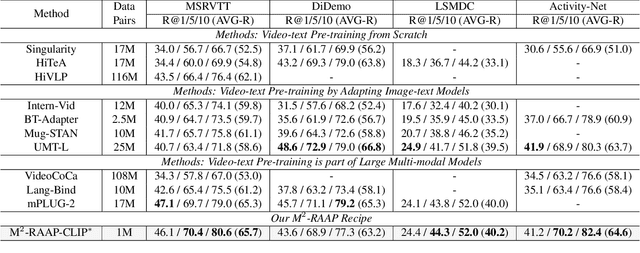
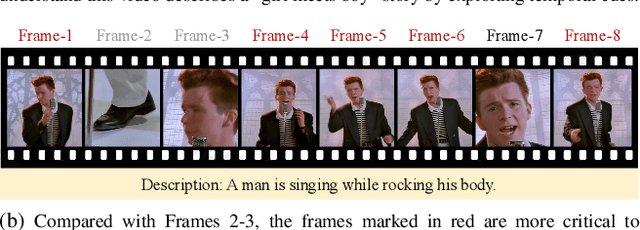

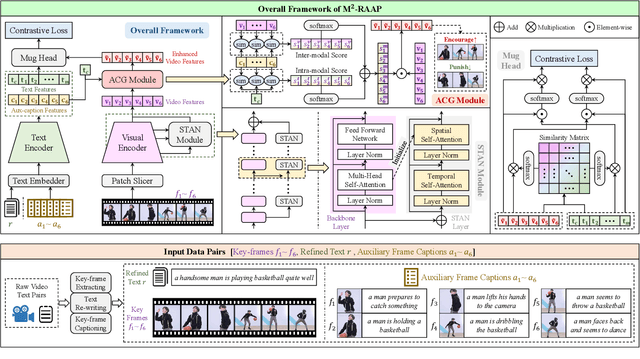
Abstract:We present a Multi-Modal Recipe for Advancing Adaptation-based Pre-training towards effective and efficient zero-shot video-text retrieval, dubbed M2-RAAP. Upon popular image-text models like CLIP, most current adaptation-based video-text pre-training methods are confronted by three major issues, i.e., noisy data corpus, time-consuming pre-training, and limited performance gain. Towards this end, we conduct a comprehensive study including four critical steps in video-text pre-training. Specifically, we investigate 1) data filtering and refinement, 2) video input type selection, 3) temporal modeling, and 4) video feature enhancement. We then summarize this empirical study into the M2-RAAP recipe, where our technical contributions lie in 1) the data filtering and text re-writing pipeline resulting in 1M high-quality bilingual video-text pairs, 2) the replacement of video inputs with key-frames to accelerate pre-training, and 3) the Auxiliary-Caption-Guided (ACG) strategy to enhance video features. We conduct extensive experiments by adapting three image-text foundation models on two refined video-text datasets from different languages, validating the robustness and reproducibility of M2-RAAP for adaptation-based pre-training. Results demonstrate that M2-RAAP yields superior performance with significantly reduced data (-90%) and time consumption (-95%), establishing a new SOTA on four English zero-shot retrieval datasets and two Chinese ones. We are preparing our refined bilingual data annotations and codebase, which will be available at https://github.com/alipay/Ant-Multi-Modal-Framework/tree/main/prj/M2_RAAP.
Knowledge-enhanced Multi-perspective Video Representation Learning for Scene Recognition
Jan 09, 2024Abstract:With the explosive growth of video data in real-world applications, a comprehensive representation of videos becomes increasingly important. In this paper, we address the problem of video scene recognition, whose goal is to learn a high-level video representation to classify scenes in videos. Due to the diversity and complexity of video contents in realistic scenarios, this task remains a challenge. Most existing works identify scenes for videos only from visual or textual information in a temporal perspective, ignoring the valuable information hidden in single frames, while several earlier studies only recognize scenes for separate images in a non-temporal perspective. We argue that these two perspectives are both meaningful for this task and complementary to each other, meanwhile, externally introduced knowledge can also promote the comprehension of videos. We propose a novel two-stream framework to model video representations from multiple perspectives, i.e. temporal and non-temporal perspectives, and integrate the two perspectives in an end-to-end manner by self-distillation. Besides, we design a knowledge-enhanced feature fusion and label prediction method that contributes to naturally introducing knowledge into the task of video scene recognition. Experiments conducted on a real-world dataset demonstrate the effectiveness of our proposed method.
Dual-Modal Attention-Enhanced Text-Video Retrieval with Triplet Partial Margin Contrastive Learning
Sep 20, 2023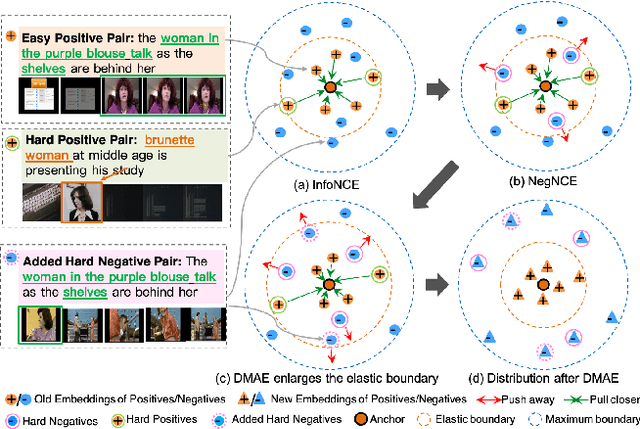
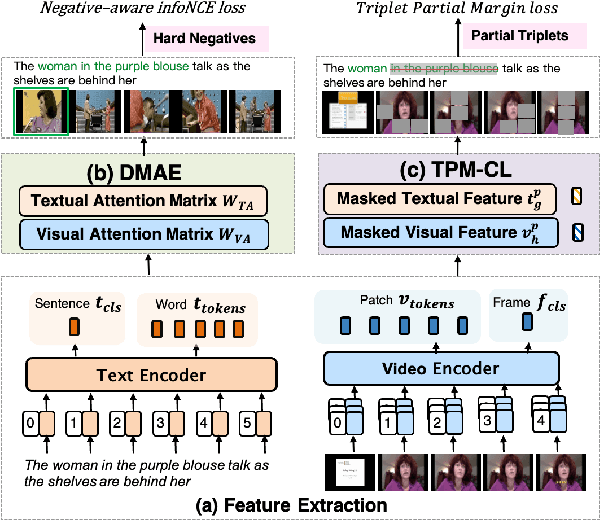
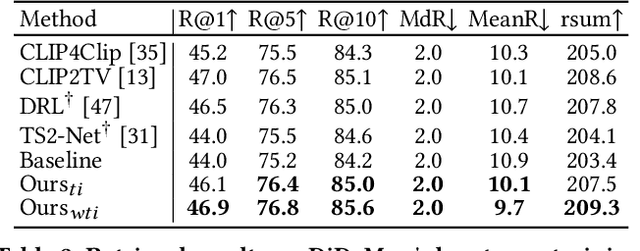
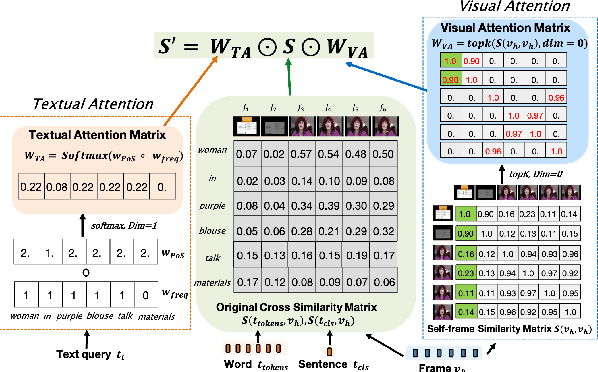
Abstract:In recent years, the explosion of web videos makes text-video retrieval increasingly essential and popular for video filtering, recommendation, and search. Text-video retrieval aims to rank relevant text/video higher than irrelevant ones. The core of this task is to precisely measure the cross-modal similarity between texts and videos. Recently, contrastive learning methods have shown promising results for text-video retrieval, most of which focus on the construction of positive and negative pairs to learn text and video representations. Nevertheless, they do not pay enough attention to hard negative pairs and lack the ability to model different levels of semantic similarity. To address these two issues, this paper improves contrastive learning using two novel techniques. First, to exploit hard examples for robust discriminative power, we propose a novel Dual-Modal Attention-Enhanced Module (DMAE) to mine hard negative pairs from textual and visual clues. By further introducing a Negative-aware InfoNCE (NegNCE) loss, we are able to adaptively identify all these hard negatives and explicitly highlight their impacts in the training loss. Second, our work argues that triplet samples can better model fine-grained semantic similarity compared to pairwise samples. We thereby present a new Triplet Partial Margin Contrastive Learning (TPM-CL) module to construct partial order triplet samples by automatically generating fine-grained hard negatives for matched text-video pairs. The proposed TPM-CL designs an adaptive token masking strategy with cross-modal interaction to model subtle semantic differences. Extensive experiments demonstrate that the proposed approach outperforms existing methods on four widely-used text-video retrieval datasets, including MSR-VTT, MSVD, DiDeMo and ActivityNet.
 Add to Chrome
Add to Chrome Add to Firefox
Add to Firefox Add to Edge
Add to Edge